If the Platte River hadn’t flooded its banks in 1965, Arapahoe Libraries might not have celebrated its 50th anniversary in 2016. Learn more about the beginnings of Arapahoe Libraries.
The aftermath of the 1965 flood
Until the flood hit, residents of unincorporated Arapahoe County could get library services through contractual arrangements made by the Arapahoe County Commissioners with other counties or municipalities that already had libraries. Arapahoe County paid those cities and entities for letting county residents in the unincorporated areas get access to their books and libraries. Adams County provided some bookmobile service, and Littleton, Aurora and Englewood allowed residents in unincorporated areas to get a library card to use their services.
When the Platte River flooded its banks in 1965, it not only took out homes and businesses along its path, it also took out bridges and other infrastructure. Suddenly the county needed the money that once went to contracted library services. The County Commissioners decided they weren’t going to renew the library contracts beginning in 1966 because there was no money in the general fund to pay for it.
Deer Trail's need for library services
The town of Deer Trail still wanted library services, and fortunately Jeanne Davies was an active member of the community. At that time, Davies’ husband Miles was serving on the Deer Trail School Board, which had been discussing ways to secure library services for the school. Miles asked Jeanne whether she might be interested in getting involved in the library issue, and she took the lead.
Davies first worked with an informal citizen’s group that established and coordinated library services between Adams and Arapahoe counties before the flood. When she, on behalf of the Deer Trail and other county groups, pressed the County Commissioners for a solution to the lack of library service, the commissioners suggested that setting up a special library district might be the answer.
State law required that two government entities had to join forces in order to establish a special taxing district. The county became one of those entities and the Deer Trail School Board became the second entity needed to oversee the special library district, which is known today as Arapahoe Libraries.
The first library board and bookmobile
A five-member board was named, and the first board members were Jeanne Davies, Norma Hamilton, William Murray, Jack Thomas and Margaret Toppel. The first organizational meeting was on April 18, 1966. In July of that year, Arapahoe Libraries received its first appropriation from the county of $34,234.12 to maintain library service for the six months remaining in 1966, and the board hired the first librarian Ann Kelver.
By the end of 1966, Arapahoe Libraries purchased a used bookmobile from a library in Missouri. After it was reconditioned, the bookmobile was stocked with books from the Colorado State Library. The bookmobile started service on February 7, 1967, and served Byers, Deer Trail, Strasburg, Bennett and East Ridge.
In 1967, Arapahoe Libraries was on the move – literally. Librarian Ann Kelver rode the newly acquired bookmobile that served the eastern part of the county, stopping at Deer Trail and Byers. While there were initially bookmobile stops in Bennett and Strasburg, by 1968, these towns were serviced by a bookmobile from Adams County.
Gradually, the number of stops expanded, and the communities of East Ridge, Holly Hills and Altura in Aurora, and the Walnut Hills and Cherry Creek areas all received regular visits from the bookmobile.
The early years of Arapahoe Libraries
According to newspaper reports from 1967, during the first full year of operation, 27,842 library cards were issued, and 3,600 books were purchased to replace the books that were on loan from the Colorado State Library.
The first library and administrative headquarters was opened in 1969 in Altura, a community east of Aurora and also thought to be the geographical center of Arapahoe Libraries service area. Unfortunately, that first library did not last long because that same year, Aurora annexed Altura. The following year, Southglenn Library in the Southglenn Shopping Center area opened (now located in The Streets at Southglenn, opens a new window) as did a branch library in the Walnut Hills Elementary School.
In 1971, Jeanne Davies was elected to her first term as president of the Arapahoe Libraries Board of Trustees. She was to be elected president another term and remain active on the board for many years to come. Davies also brought distinction to Arapahoe Libraries by not only being active in local library issues, but also serving on the board for the Colorado Library Association, opens a new window as well as the national American Library Trustees.
Deer Trail and Byers libraries open
Throughout the 1970s, branch libraries in the western service area opened, expanded, closed, moved to larger locations and were named and renamed; however, on the eastern plains by June 1973, the bookmobile took on a new life and was parked in Byers and opened two days each week as a branch library.
The years of support and involvement of the Deer Trail School Board were rewarded in 1978 when the Deer Trail Public Library opened. The library, a combined school and public facility, opened in the Deer Trail School, where it is still located today.
By 1979, the Byers Library, outgrowing its converted bookmobile space, combined with the elementary school library and moved into the Byers Elementary School. In 1984, after outgrowing the school space, the library moved to a modular building adjacent to the school and was renamed the Ann E. Kelver Library, in honor of Arapahoe Libraries’ first director, who also retired that year.
In 1989, in honor of Jeanne Davies, who currently resides in Littleton, Arapahoe Libraries recognized her more than 20 years of contributions by naming the Deer Trail Library the Jeanne Davies Public Library. Fifty years later, Davies still serves Arapahoe Libraries by being a member of the Board of Trustees’ financial oversight committee.
Thank you to Michelle C. for her work researching and writing this article. To learn more about our history, visit Who We Are.


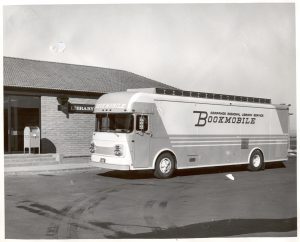
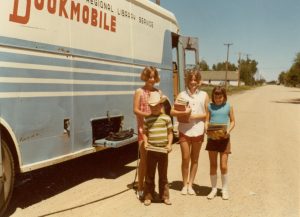
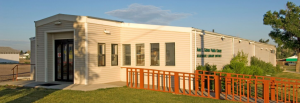
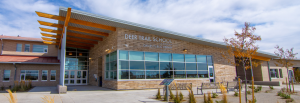
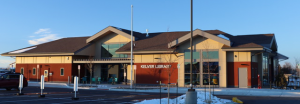

Add a comment to: Arapahoe Libraries Rooted in Eastern Plains